-
 2022. December VOL. 657
2022. December VOL. 657
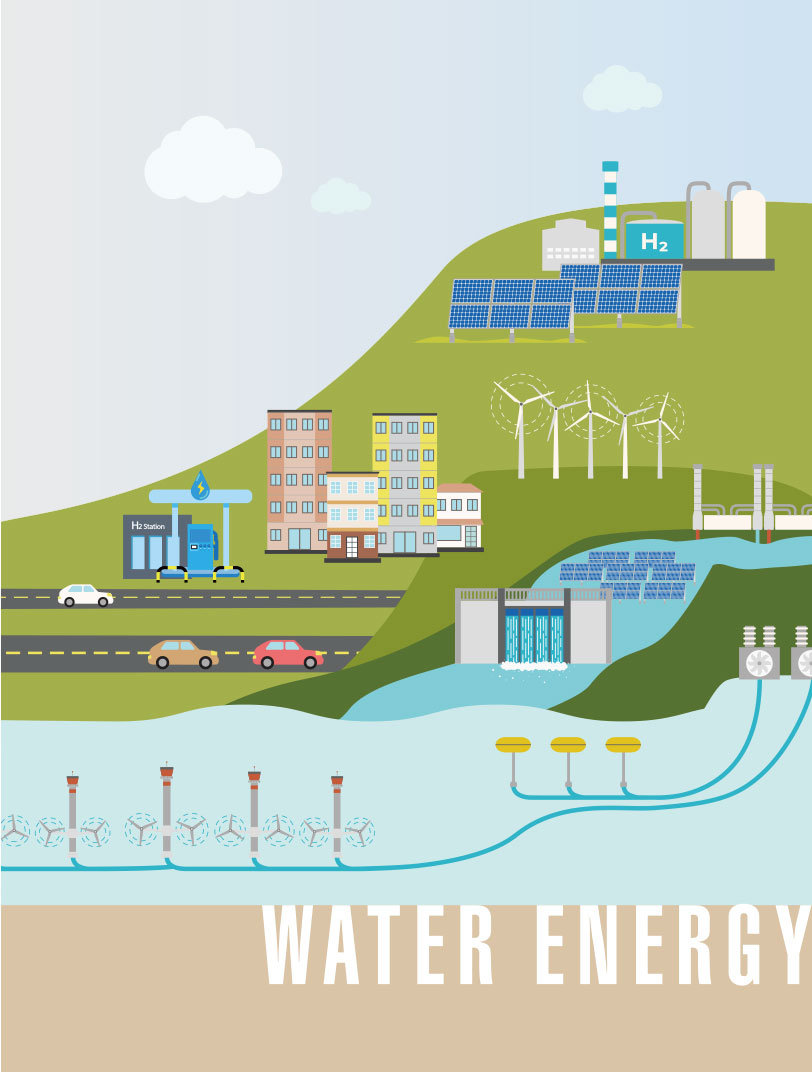
Water is an important source of energy. K-water continues to expand the development of clean energy by combining water and energy, including hydro, tidal, hydrothermal, and floating photovoltaic power generation.
K-water, the No. 1 renewable energy corporation in Korea, is working diligently on the development and propagation of water-based clean energy. K-water’s new renewable energy production capacity stood at 1,413MW as of end of 2021, and it is creating 2,244GWh of clean energy.
K-water is implementing a range of different projects to increase the generation of floating photovoltaic power and hydrothermal energy, which are quickly emerging as new renewable energy. A floating photovoltaic power plant is an environment-friendly power generation facility constructed with photovoltaic modules installed on the surface of water at a dam.
K-water is operating floating photovoltaic power generation facilities with total capacity of 49.6MW at the Hapcheon, Boryeong, and Chungju dams under its management and is working on the construction of floating photovoltaic power plants at the Imha and Gunwi dams, too.
K-water’s floating photovoltaic power generation project has adopted a business model designed to involve local communities and generate new values through profit sharing with local residents. For example, local residents investing in the project in the form of taking out a loan can get up to 10% interest payment. Hapcheon Dam is operating a floating photovoltaic power plant with capacity of 41.5MW as Korea’s largest by involving local residents in the project; thus creating jobs and contributing to the local economy.
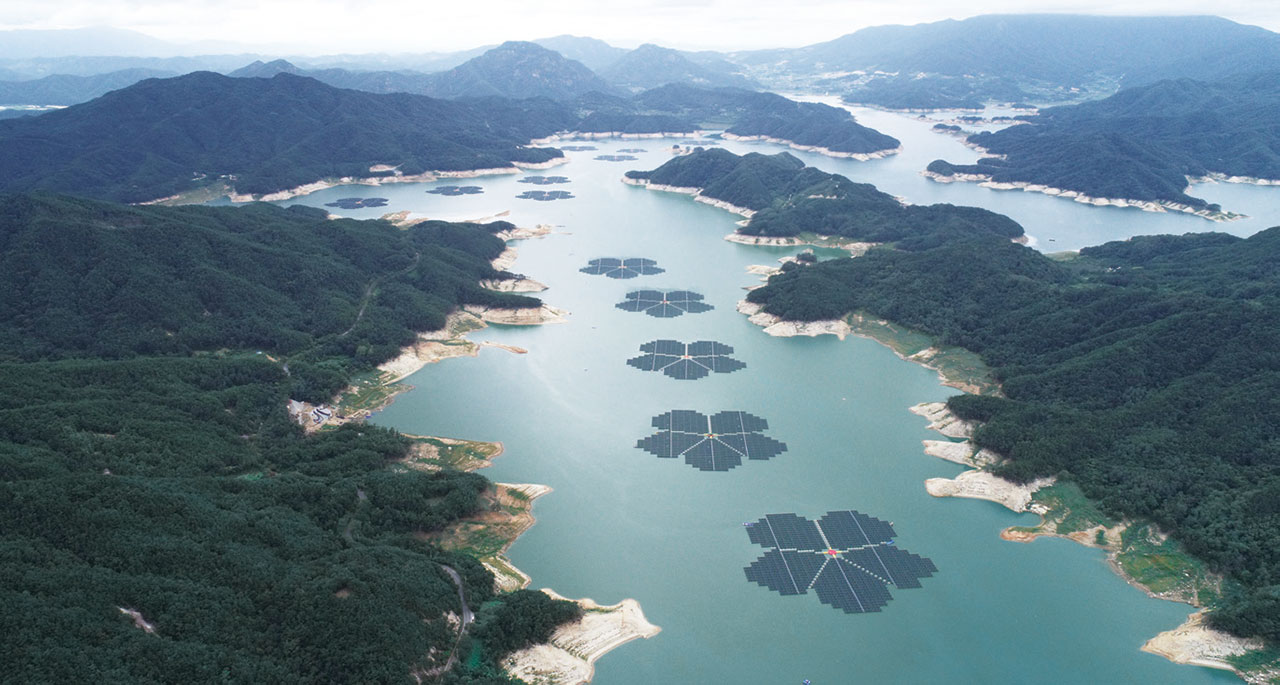 Floating photovoltaic power plant at Hapcheon Dam
Floating photovoltaic power plant at Hapcheon Dam
K-water is working on a large-scale project to develop 286,000RT of hydrothermal energy by 2030. Hydrothermal energy is generated by using high-temperature hydrothermal resources including hot water from the deep reservoirs of dams and from raw water pipes connected to a water supply system. It is used mainly for heating and cooling for buildings.
Over the years, K-water has launched a number of projects to promote the production and use of hydrothermal energy. Specifically, it is supplying 3,000RT of hydrothermal energy, the largest scale in Korea, generated from the raw water of the metropolitan water supply system, to Lotte World Tower. It also constructed the hydrothermal energy facility for EDC Smart Village in Busan. In this project, K-water established Korea’s first heating and cooling system for a residential complex by using water from nearby rivers and streams. The environment-friendly energy city was created in November 2021.
Currently, K-water is building the ‘Hydrothermal Energy Convergence Cluster’ in Gangwon-do, where hydrothermal energy generated from the deep water in Soyanggang Dam is used for the cooling of a data center. Construction will be completed by 2027, and K-water will operate the facility for 30 years from 2028 to 2057.
In addition, it is working with the Ministry of Environment on the ‘hydrothermal energy use promotion and support pilot project’ that subsidizes up to 50% of the total cost of hydrothermal energy projects implemented by the private sector and local governments as part of its efforts to encourage the nationwide use of hydrothermal energy. In March 2022, K-water came up with a list of nine beneficiary organizations for the pilot project including Samsung Medical Center, Seoul, and Korea International Trade Association, and it plans to offer subsidy for the design and construction cost and technological support by 2024. The project is expected to reduce annual electricity consumption for their entire heating and cooling facilities by 35.8% or 36.5GWh and reduce greenhouse gas emissions by 19,000 tons per year.
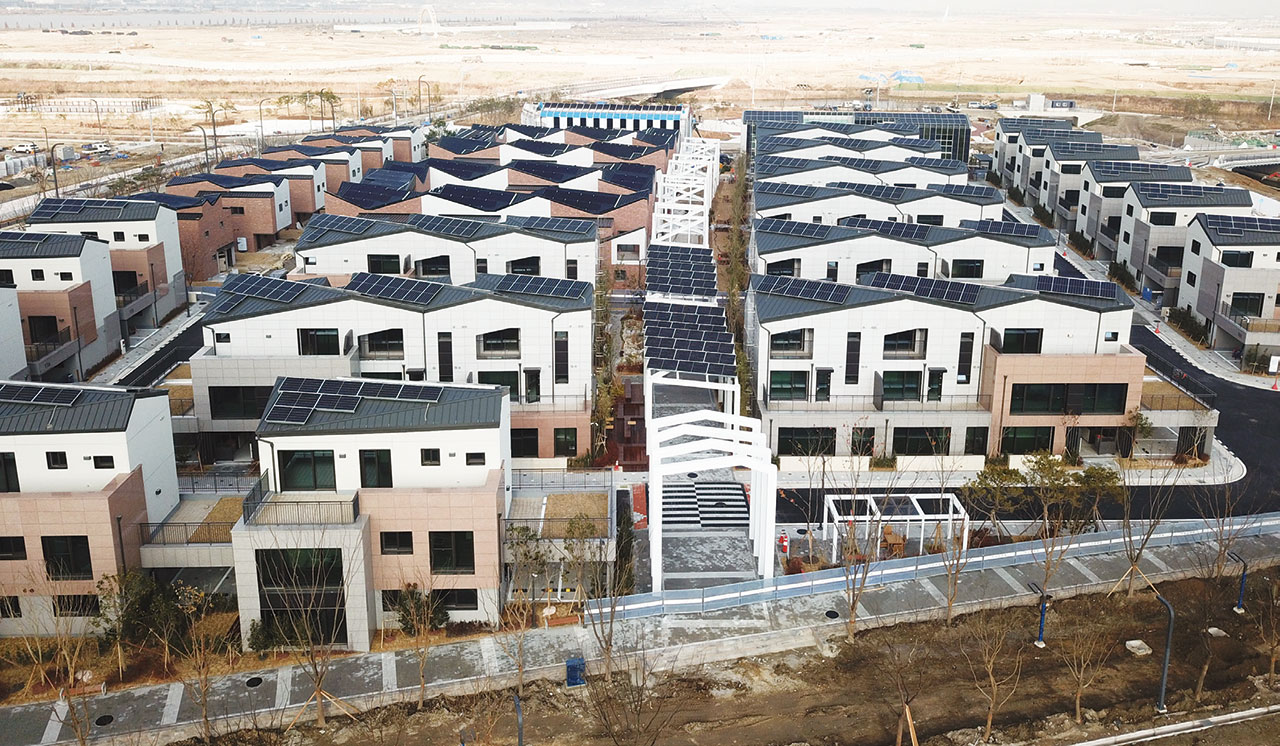 Eco Delta City(EDC) Smart Village in Busan
Eco Delta City(EDC) Smart Village in Busan
K-water produces electricity by using water in hydro and tidal power generation. Hydro power is the largest power generation resource of all. In hydro power generation, the potential energy of water in a river or a dam is used to spin a turbine, converting it into kinetic energy and again into mechanical energy to induce electromagnetism inside a generator and finally generate electricity. There are 10 large hydro power plants and 53 small hydro power plants under its management. These plants produce combined electricity of 1,764GWh per year, equivalent to the amount of electricity that approximately 1.6 million people can use for a year.
Tidal power is clean energy created by the moon and water working together. A turbine is spun by the power of water flowing into a turbine generator during the rise of ocean tides. The tidal power plant built at Sihwaho Lake in Ansan, Gyeonggi-do is the world’s largest in terms of installed capacity, which is equal to 12 soccer fields combined. The plant produces 552GWh of electricity every year, which can be used by around 500,000 people for up to a year.
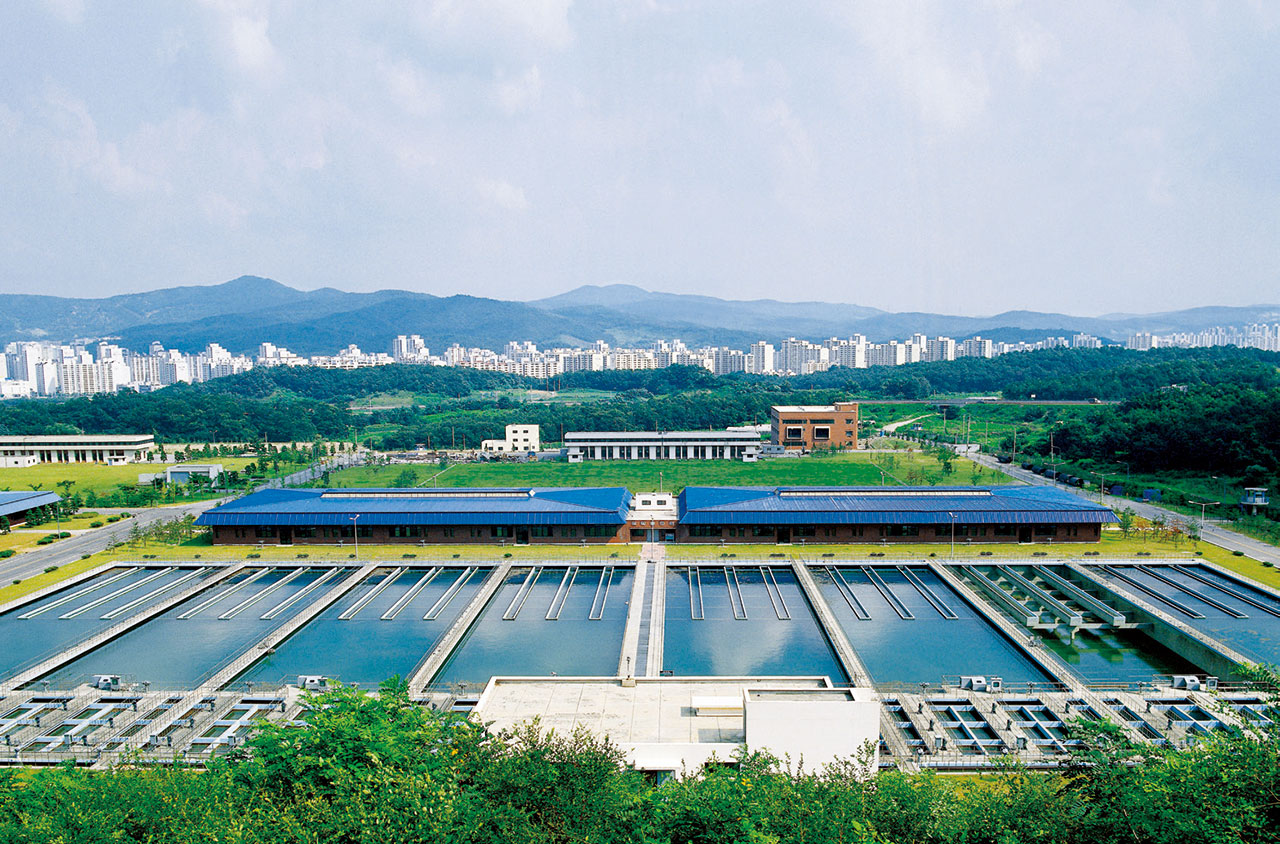 Seongnam Water Purification Plant
Seongnam Water Purification Plant
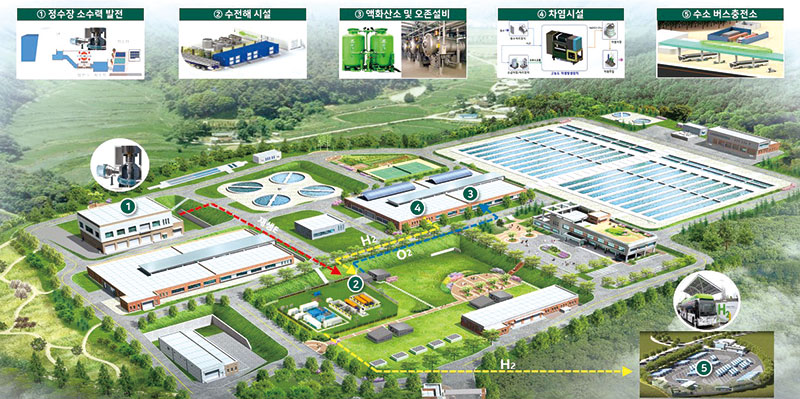 Test-bed plant research on hydrogen production and added value creation at the Seongnam Water Purification Plant
Test-bed plant research on hydrogen production and added value creation at the Seongnam Water Purification Plant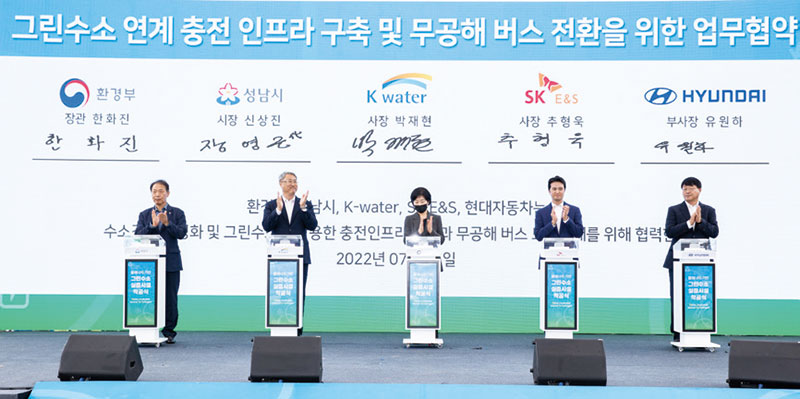 MOU on the construction of green hydrogen-based charging infrastructure
MOU on the construction of green hydrogen-based charging infrastructure
K-water is planning to produce 34,000 tons of green hydrogen per year by 2050, thereby contributing to the growth of the national hydrogen economy. Green hydrogen is becoming increasingly popular because it does not emit carbon dioxide during its production process. Green hydrogen is environment-friendly renewable energy produced with the electrolysis of water. Against this backdrop, K-water has been implementing two green hydrogen empirical research projects this year, accelerating the commercialization of its green hydrogen technology.
The empirical research project at the Seongnam Metropolitan Water Purification Plant is aimed at creating the country’s first green hydrogen production facility using small hydro power, and K-water will create a green hydrogen life cycle model by working with the Ministry of Environment, Seongnam City, Hyundai Motor Group, and SK E&S. The facility is scheduled for completion by early next year, which will be followed by empirical research and commercialization research. Approximately 69 tons of green hydrogen can be produced every year with the electrolysis of water flowing in from Paldang Dam to the Seongnam Water Purification Plant. This translates into some 188kg of hydrogen that can charge 37 hydrogen fuel-driven vehicles a day.
The Ministry of Environment and K-water are planning to increase green hydrogen production using renewable energy by successfully carrying out the empirical research project at the Seongnam Water Purification Plant. They are also working on the construction of hydrogen infrastructure capable of producing 240kg of green hydrogen a day using wind power in Ansan-si. Upon completion of installation and test-operation scheduled for next year, K-water will subsequently embark on empirical and commercialization research.
K-water has been conducting in-house research on green hydrogen since 2021, based on which it has verified the feasibility of its water-based green hydrogen production technology; thus providing fresh momentum for its research activities. In July 2022, K-water signed an MOU on the Promotion of Green Hydrogen Research under which it is working with Korean organizations possessing source technologies for green hydrogen production to improve technological competence through joint research projects and create an industry-academe-research cooperation network.
K-water CEO Jae-hyeon Park said, “K-water, the No. 1 renewable energy company in Korea, is committed to developing clean water energy including floating photovoltaic energy and hydrothermal energy and promoting the widespread use of water-based renewable energy through close collaboration with other organizations.”
